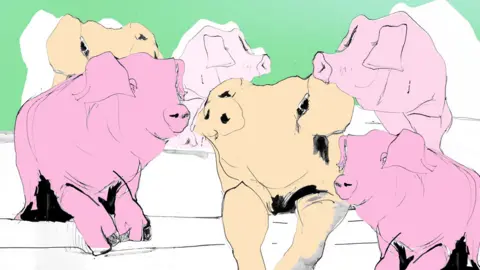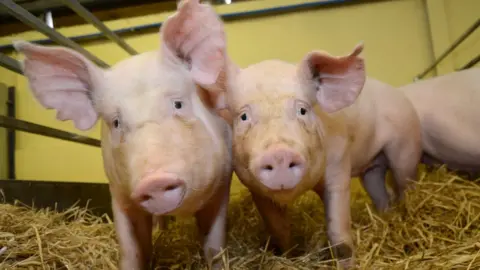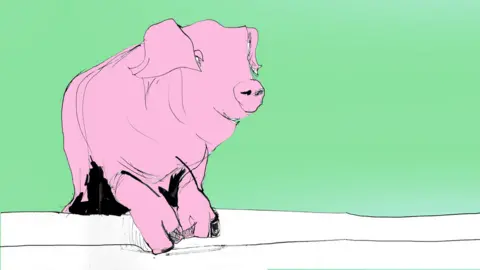Gene-edited farm animals are on their way
 BBC
BBCScientists have created pigs that are immune to one of the world's costliest livestock diseases.
The team edited the animals' DNA to make them resist the deadly respiratory disease known as PRRS - a move that could prevent billions of pounds in losses each year.
However, consumers have traditionally been reluctant to eat genetically altered animals and crops.
This poses a significant barrier to farmers owning gene-edited pigs.
And because genome, or gene, editing (GE) is relatively new, the absence of regulation currently prevents their sale anyway.
GE is different to the more widely used technology of genetic modification. The former involves the precise alteration of an organism's DNA, while the latter is characterised by the introduction of foreign genetic sequences into another living thing.
 Norrie Russell
Norrie RussellThe pig research also raises animal welfare issues. Critics say that creating disease-resistant animals will discourage farmers from improving the welfare of their livestock. Some think that the way the animals are kept can make them less prone to contracting the virus that causes PRRS.
PRRS, which stands for Porcine Reproductive and Respiratory Syndrome, can cause breathing problems and death in young pigs.
Why don't consumers want to eat genetically altered foods?
In the past, there have been fears (unsupported by scientific evidence) that GM foods might cause harm to human health.
Among those concerns are that the products of modified crops or animals might trigger allergies or that genes inserted into the food would get into human DNA.
But GM foods have been available for decades and no adverse effects on humans have ever been reported.
In its guidance, the World Health Organization (WHO) says: "No effects on human health have been shown as a result of the consumption of such foods by the general population in the countries where they have been approved."

So, what did the scientists do?
Researchers at the University of Edinburgh's Roslin Institute used gene editing to delete a small region of pig DNA. But this relatively small edit prevents the PRRS virus from gaining a foothold on the surfaces of pig cells.
The scientists then exposed four of their gene-edited pigs to the PRRS virus. Writing in the Journal of Virology, they report that none became ill.
Research leader Dr Christine Tait-Burkard stressed that no foreign genes were inserted into the pig. She added that tests so far showed that the animals are not weakened or affected in any other way by the process.
"The animals are all pig… with just a tiny section snipped out. The main thing that this edit will do is… benefit animal welfare because the animals will not get a very devastating disease," she said.
The genetic edit is permanent, so disease resistance will be passed down the generations through natural breeding.
What's not to like?
Helen Browning of the Soil Association believes that this approach deals with the symptoms of a problem, rather than addressing the root causes.
She has kept pigs for 30 years on her organic farm in north Wiltshire. Ms Browning says that keeping them outdoors and having higher welfare standards makes the animals less prone to disease.
"If gene editing is being used for disease resistance and it is not encouraging companies to change the way they keep their pigs so they don't get disease in the first place, then it becomes a problem rather than a solution," Ms Browning said.

When can I tuck into a gene-edited bacon butty?
That's still several years away. While the technology is almost in place, the regulations are not and some are calling for a public debate first.
"First and foremost we need a broader conversation on the acceptability of gene-edited meat entering our food chain, to help inform political leaders on how these techniques should be regulated," Dr Tait-Burkard told BBC News.
"If these studies are successful and the public are accepting of this technology, we would then be looking to work with pig breeding companies to integrate these gene edits into commercial breeding stocks."

What else is gene-editing being used on?
The PRRS-resistant pig project is one of several research efforts across the world to create gene edited animals for livestock production.
Among them is a project to make domestic pigs more resistant to African swine fever.
Researchers are also trying to increase the muscle mass of sheep and cows by deleting a small section of DNA. They are trying to mimic a trait that occurs naturally in Belgian Blue cattle.
What's the catch?
There is a tension between the needs of the producer and of animal welfare.
In 1989, researchers working for the US Department of Agriculture in Beltsville, Maryland, added a gene into the DNA of a pig that would produce a human growth hormone. The expectation was that the animal would grow faster and be leaner than normal pigs.
The researchers were successful: weight gain increased by 15%, feed efficiency by 18%, and carcass fat was reduced by 80%.
But the animals suffered from several unanticipated health problems, including kidney and liver problems, uncoordinated walking, bulging eyes, gastric ulcers, heart disease and pneumonia.
The catastrophic failure of the now infamous "Beltsville Pig" resulted in a voluntary moratorium on growth hormone experiments on mammals in the US.
Because gene editing is more precise, those working in the area believe that it is much less likely to lead to unanticipated side effects.
Dr Tait-Burkard cited the example of double-muscled livestock, a trait which can be introduced through genetic modification or editing or through regular breeding - as in the Belgian Blue cattle.
"Whilst making animals resistant to diseases by genome editing will automatically also aid productivity it presents immediate benefits to animal welfare. However, when we look at traits such as the double-muscled [attribute in] animals there are no real upsides but mostly downsides to animal welfare," Dr Tait-Burkard explained.
Illustrations by Katie Horwich
